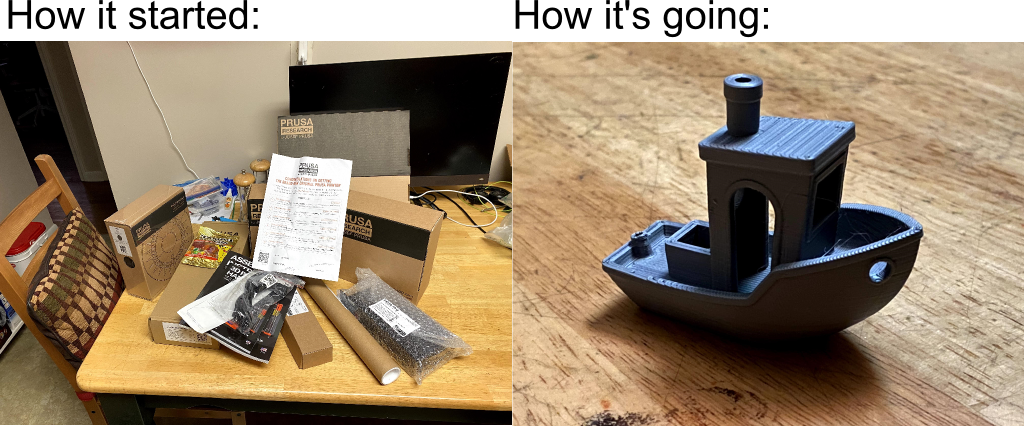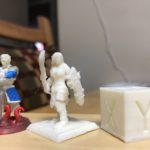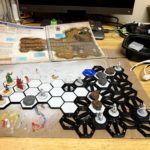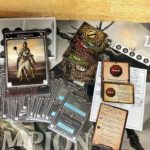I chose my first 3D printer carefully. I lurked on r/3dprinting for months, reading all their guides, looking at what they were printing, finding people who were doing the sorts of things with their printer that I wanted to do, and finally ordered the best of the bunch: The Creality Ender 3 Pro. There was a lot of help for it and a lot of support, and I was so excited by it, that I ordered it the moment I had a couple hundred bucks I didn’t need. Because it was affordable, too. Budget printing for amazing results.
It came as a kit with very, very poor instructions. I read them carefully (mostly pictures without text), and watched videos, and after awhile I managed to get it so it looked like the pictures. I then found out I’d built the X-axis arm wrong, and had to take it apart and fix it. There was something else I messed up, too, that I found and fixed.
What followed was months of frustration as every successful print was preceded by three or four false starts and a bed that wouldn’t stay level. The bed leveling system is done via four knobs on springs which gradually lose tension during the printing process, shifting the Z-axis down. (People replace those springs with better ones as part of a common mod). The rollers that control the X and Y axes aren’t 100% smooth, leading to uneven printing (this can be ameliorated somewhat). The belt tensioning system is primitive, making it hard to dial in the correct tension, leading to the occasional layer slip.

When someone paid me a debt, I used that money to buy what I should have bought the first time: a Prusa. I think I could (and will) fix the Ender; it has printed many, many things for me that came out great. But I really want a more “just print it” solution.
I bought the Prusa i3 Mk3s as a kit, though you can order it assembled and tested. I thought it wouldn’t be any more complicated that the Ender 3, but I was wrong about that. It took me all of a Sunday to put together the frame and the XYZ motors, another night to put together the extruder assembly, and a third night to hook up the electrics, test, and calibrate the printer.
But since then, I have printed many, many things and have not had to readjust anything even once. I hit print and it prints.
Instead of rollers, the Prusa uses rails and bearings — very smooth. (You can make this mod on the Ender 3, but Prusa comes that way). It has two Z axis motors instead of one, better supporting the X axis arm. (The Ender has just one; the other end is unsupported, and it droops a little as a consequence). The Prusa print bed isn’t supported by springs, but with metal spacers — nothing to loosen. The Prusa samples nine points (or more, if you want) on the print bed and adjusts itself to account for any imperfections before every print. During calibration, I’d printed half a dozen test patterns and found the perfect offset between the bed leveling sensor and the print head, and I haven’t needed to touch it since.
PrusaLabs was started in 2012 in Prague, Czech Republic. Its founder, Josef Prusa, is still actively developing new iterations of his famous printer (including a resin printer and new, cheaper, mini printer).
The manual is extensive. And every chapter has a QR code you can scan for the latest version of that chapter, specific videos and so on. I was a little surprised to find a package of gummy bears in with the printer hardware when I opened the box. The gummy bears are meant to be eaten in specific quantities and times as rewards as you work through assembling the printer.
There was SO MUCH HELP AND POSITIVITY in the manual. I felt so good putting the machine together last week, compared to the cloud of frustration I felt when I put together the Ender. The results speak for themselves. Maybe if the Ender had the same sort of well-written manual, I wouldn’t have made so many mistakes assembling it. Instead, it came with a folding sheet of paper with IKEA-level diagrams.
You’ll be reading a lot more about this printer in this blog. I’m just going to suggest that if someone is looking for a 3D printer that “just works”, go for the Prusa. If you really want to get into the weeds of modifying a printer and making it truly yours more than you want to use it for printing, the Ender is your baby. There’s many sites that list the top 25 or 50 mods to print for your Ender. At the end you’ll have something that is uniquely yours, but using my printer to just print a better printer isn’t what I’m going for here.




